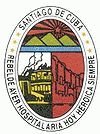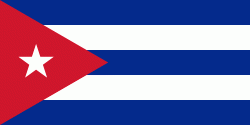Santiago de Cuba (Municipio de Santiago de Cuba)
 |
The municipality extends over 1023.8 km2, and contains the communities of Antonio Maceo, Bravo, Castillo Duany, Daiquirí, El Caney, El Cobre, El Cristo, Guilera, Leyte Vidal, Moncada and Siboney.
Historically Santiago de Cuba was the second-most important city on the island after Havana, and remains the second-largest. It is on a bay connected to the Caribbean Sea and an important sea port. In the 2012 population census, the city of Santiago de Cuba recorded a population of 431,272 people.
Santiago de Cuba was the fifth village founded by Spanish conquistador Diego Velázquez de Cuéllar on July 25, 1515. The settlement was destroyed by fire in 1516, and was immediately rebuilt. This was the starting point of the expeditions led by Juan de Grijalba and Hernán Cortés to the coasts of Mexico in 1518, and in 1538 by Hernando de Soto's expedition to Florida. The first cathedral was built in the city in 1528. From 1522 until 1589, Santiago was the capital of the Spanish colony of Cuba.
The city was plundered by French forces in 1553, and by English forces in 1603. More than 50 years later the English raided again in 1662 under Christopher Myngs.
The city had a huge influx of French and British immigrants in the late 18th and early 19th centuries. Some eighteen thousand Saint Dominican refugees, both ethnic French whites and free people of color, and African freedmen, came from Saint-Domingue in the summer of 1803 during the last days of the Haitian slave revolt, which had started in 1791. Other refugees had emigrated from Saint-Domingue earlier in the revolution. Haiti declared its independence as a republic in 1804.
The French were withdrawing surviving troops after suffering heavy losses from warfare and yellow fever. The immigrants, who included freedmen as France had abolished slavery on Saint-Domingue, struggled to maintain their freedom in Cuba, which was still a slave society. Cuba initially allowed only white refugees, women of color, children, and loyal "domestics" to land; French troops and all men of color over the age of thirteen were held off shore, to be rapidly deported to the mainland, as they were considered a revolutionary threat. Some French soldiers joined other refugees in Charleston, South Carolina, or New York City; others went to New Orleans.
The refugees who stayed added to the city's eclectic cultural mix, already rich with Spanish and African culture. Some of the women and children were impressed into slavery again, although they had been free. In 1809, after Napoleon Bonaparte's forces invaded Spain, French citizens were ordered out of Cuba. Most went to the United States, and thousands settled in New Orleans, with the freedmen increasing its African culture, as most had been born in Africa. The ethnic French whites and free people of color, generally with longer ties to French culture, added their flavor to the culture of the city as well.
Near the end of the century, during the Spanish–American War, Santiago was the site of the major defeat of Spanish troops at San Juan Hill on July 1, 1898. After capturing the surrounding hills, United States General William Rufus Shafter laid siege to the city. Spain later surrendered to the United States after Admiral William T. Sampson destroyed the Spanish Atlantic fleet just outside Santiago's harbor on July 3, 1898. Cuba had declared independence from Spain but was occupied by US troops for several years. Historians suggest they were there to ensure the sugar economy continued to be productive.
José Martí, a Cuban poet, writer, and national hero, is buried in Santa Ifigenia Cemetery in this city.
Map - Santiago de Cuba (Municipio de Santiago de Cuba)
Map
Country - Cuba
 |
 |
| Flag of Cuba | |
The territory that is now Cuba was inhabited by the Ciboney people from the 4th millennium BC with the Guanahatabey and Taíno peoples until Spanish colonization in the 15th century. From the 15th century, it was a colony of Spain, and slavery was abolished in 1886, remaining a Spanish colony until the Spanish–American War of 1898, when Cuba was occupied by the United States and gained independence in 1902. In 1940, Cuba implemented a new constitution, but mounting political unrest culminated in a coup in 1952 and the subsequent dictatorship of Fulgencio Batista, which was later overthrown in January 1959 by the 26th of July Movement during the Cuban Revolution, which afterwards established communist rule under the leadership of Fidel Castro. The country was a point of contention during the Cold War between the Soviet Union and the United States, and a nuclear war nearly broke out during the Cuban Missile Crisis of 1962. Following the collapse of the Soviet Union, Cuba faced a severe economic downturn in the 1990s, known as the Special Period. In 2008, Fidel Castro resigned after 49 years of leadership of Cuba and was replaced by his brother Raúl Castro.
Currency / Language
| ISO | Currency | Symbol | Significant figures |
|---|---|---|---|
| CUC | Cuban convertible peso | $ | 2 |
| CUP | Cuban peso | $ | 2 |
| ISO | Language |
|---|---|
| ES | Spanish language |
















